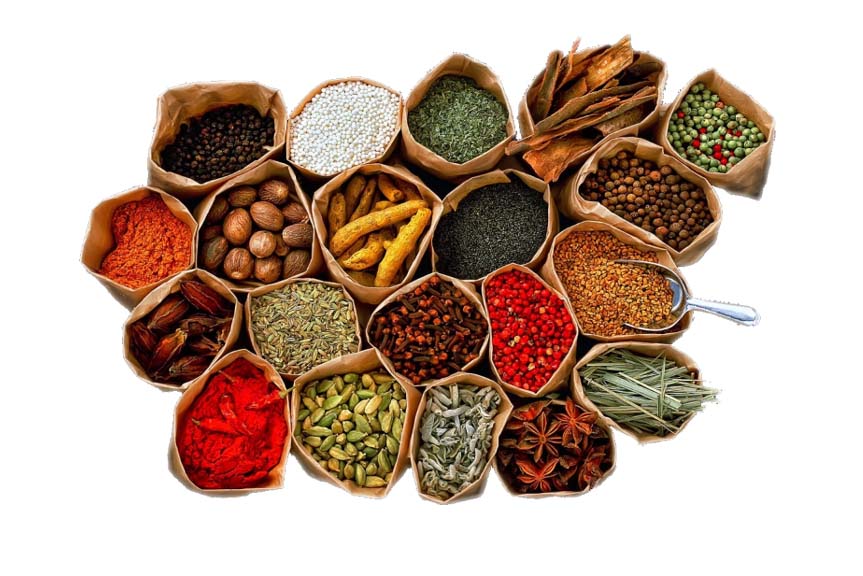Index of herbs and spices

Herbs and spices are essential elements in the world of culinary arts, revered for their ability to transform ordinary dishes into extraordinary culinary experiences. Herbs, often derived from the leaves of plants, provide a burst of fresh, aromatic flavors that can elevate a meal to new heights. Whether it’s the earthy aroma of basil, the zesty tang of cilantro, or the sweet fragrance of mint, herbs bring a diverse array of tastes and scents to the kitchen. In contrast, spices, typically sourced from the seeds, bark, or roots of plants, impart intense and often warming flavors. From the fiery kick of chili powder to the comforting warmth of cinnamon, spices introduce complexity and depth to recipes. Together, herbs and spices are the alchemical agents that chefs and home cooks alike use to craft culinary masterpieces that celebrate the rich tapestry of global flavors and traditions, making dining a delightful and memorable adventure.
Herbs and Spices start with A
Herbs and Spices start with B
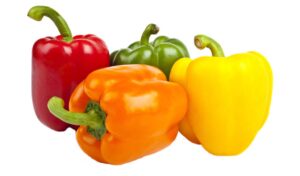 Bell Pepper
Bell Pepper
In the realm of botanical wonders, we encounter the bell pepper, also recognized as the sweet pepper or, in select locales, the capsicum, an esteemed member of the Capsicum annuum botanical family. This remarkable vegetable possesses attributes characterized by a crisp, saccharine, and subtly tart flavor profile. It has achieved global prominence as a cherished ingredient across a multitude of culinary traditions, celebrated not only for its gustatory attributes but also its resplendent hues, which span the spectrum, including fiery reds, verdant greens, sunny yellows, and vibrant oranges.
Salient attributes that distinguish the bell pepper encompass :
Chromatic Diversity: The bell pepper dons a kaleidoscope of hues, each endowing it with a distinct gustatory character. Green bell peppers, harvested prior to reaching full maturity, bear a faint bitterness in contrast to their fully ripened counterparts. The red, yellow, and orange varieties, having undergone full maturation, are celebrated for their heightened sweetness and milder flavor profiles.
Morphological Variability: Typically manifesting a form reminiscent of a bell, complete with three or four lobes adorning its base, bell peppers exhibit a spectrum of dimensions, ranging from diminutive to substantial, and an assortment of shapes, encompassing both blockish and elongated forms.
Nutritional Abundance: The bell pepper emerges as a veritable trove of nutritional bounty. It stands as a formidable source of vital vitamins, with an emphasis on vitamin C, in addition to bestowing essential nutrients such as vitamin A, vitamin K, and an array of potent antioxidants. Its caloric and lipid content is modest, rendering it an impeccable addition to a well-rounded dietary regimen.
Culinary Versatility: The bell pepper gracefully weaves itself into an extensive tapestry of culinary creations, both in its raw and cooked states. Frequently subjected to the art of slicing or dicing, it garnishes salads, embellishes sandwiches, and introduces a satisfying crunch to various gastronomic compositions. Equally, it lends itself to sautéing, roasting, or grilling, a metamorphic process that amplifies its inherent sweetness and augments its gustatory allure.
The bell pepper, replete with its chromatic exuberance, transcends its role as a mere ingredient, emerging as a veritable muse for culinary artisans, enriching an assortment of delectable endeavors, from the vivacious stir-fries and zesty fajitas to the exquisite realm of stuffed peppers and the comforting embrace of soups. Its radiant palette not only entices the visual senses but also orchestrates a symphony of flavors that harmoniously elevates myriad culinary compositions.
 Black Pepper
Black Pepper
Black pepper, scientifically known as Piper nigrum, is a widely used spice derived from the berries of the pepper plant, which is native to South India. It is one of the most popular and commonly used spices worldwide. Black pepper has been used in cooking for centuries and is valued for its strong, pungent flavor and aromatic qualities.
Here are some key characteristics and uses of black pepper:
- Flavor: Black pepper has a sharp, spicy, and slightly earthy flavor. It provides a distinctive heat and depth of flavor to a wide range of dishes.
- Culinary Uses: Black pepper is a versatile spice used in a variety of culinary applications. It is often used as a seasoning for meats, poultry, seafood, vegetables, and soups. It can be added to both savory and sweet dishes to enhance their flavor.
- Forms: Black pepper is available in various forms, including whole peppercorns, cracked pepper, and ground pepper. Whole peppercorns are the dried, unripe berries of the pepper plant, while cracked pepper consists of coarsely crushed peppercorns. Ground pepper is finely powdered pepper.
- Peppercorn Varieties: There are different varieties of peppercorns, each with its own unique flavor profile. The most common are black pepper, white pepper (from ripe berries with the outer husk removed), and green pepper (from unripe berries). Each type of pepper has distinct flavor notes and culinary uses.
- Medicinal Uses: Black pepper has been used in traditional medicine for its potential health benefits. It contains a compound called piperine, which is believed to have antioxidant and anti-inflammatory properties. Some studies suggest that piperine may enhance the bioavailability of certain nutrients.
- Preservation: Historically, black pepper was highly valued for its ability to preserve food, especially in the days before refrigeration. Its antimicrobial properties helped inhibit the growth of bacteria and fungi.
- Global Use: Black pepper is a staple spice in cuisines around the world. It is used in various spice blends, such as curry powder and garam masala in Indian cuisine, as well as in the classic French spice blend known as “five-spice” or “five-pepper” mix.
Overall, black pepper is a fundamental spice that adds depth and heat to a wide range of dishes and is an essential ingredient in many culinary traditions.
 Butter
Butter
Butter is crafted from the fat and protein elements found in milk, making it a dairy product. It is typically composed of water, milk solids, and butterfat. The process of making butter involves separating the fat from the liquid components of milk, usually through churning. This mechanical process agitates the cream until the fat globules clump together to form butter.
Butter proves to be a flexible element applied in cooking, baking, and as a spread, introducing flavor, moisture, and richness to an array of dishes. In addition to its culinary uses, butter is also a source of essential fatty acids and fat-soluble vitamins. Different regions may have variations in the type and taste of butter, and there are also variations like clarified butter (ghee) that has had the water and milk solids removed, leaving only the pure butterfat.
Herbs and Spices start with C
Cilantro / Coriander
Cilantro is a popular herb that is commonly used in cooking around the world, especially in Latin American, Asian, and Middle Eastern cuisines. It is also known as coriander in some regions, and its scientific name is Coriandrum sativum. Cilantro is a versatile herb that is valued for its fresh, citrusy, and slightly peppery flavor.
Both the leaves and the seeds of the cilantro plant are used in cooking:
- Cilantro Leaves: The leaves of the cilantro plant are often used as a garnish or ingredient in various dishes. They are particularly popular in Mexican, Thai, Indian, and Vietnamese cuisine. Cilantro leaves are often added to salsas, salads, curries, soups, and as a topping for tacos and other dishes.
- Coriander Seeds: When cilantro plants mature, they produce seeds known as coriander seeds. These seeds have a different flavor profile than the leaves. They are earthy, citrusy, and slightly nutty. Coriander seeds are commonly used as a spice in both whole and ground form in various dishes, including curry powders, spice blends, and pickling recipes.
Cilantro is known for its strong and distinctive flavor, which some people love, while others may find it polarizing. It’s often used to add a burst of fresh, herbal flavor to a wide range of dishes, and it can be an essential ingredient in many cuisines.
Cinnamon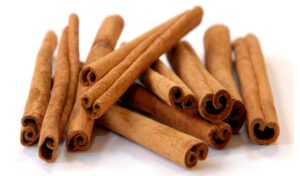
Cinnamon, that fragrant spice, derived from the inner bark of trees, particularly the noble Cinnamomum genus. It boasts a warm and sweet flavor, like a cozy hug for your taste buds, elevating culinary concoctions to new heights. Cinnamon manifests in two primary forms: ground cinnamon, a fine, powdery wonder, and cinnamon sticks, bark’s elegant swizzle sticks. It’s not just a spice; it’s the unsung hero of sweet treats, curries, and even the piping-hot embrace of cinnamon tea. Yet, its allure extends beyond the kitchen. Cinnamon, with its mysterious powers, dabbles in antioxidants and maybe even sugar’s unruly behavior. Its aroma, intoxicatingly unique, its taste, a world traveler’s diary. It’s the spice that schools your senses and charms your soul.
Herbs and Spices start with D
 Dandelion
Dandelion
Dandelion is a flowering plant belonging to the Taraxacum genus, known for its bright yellow flowers and distinctively toothed leaves. Considered a weed in some regions, every part of the dandelion – including its leaves, flowers, and roots – has been utilized for culinary, medicinal, and even cultural purposes. Dandelion greens are edible and are often used in salads or cooked as vegetables due to their slightly bitter taste. Additionally, dandelion root has been used in herbal medicine for various purposes, such as promoting liver health, aiding digestion, and acting as a diuretic. The plant is also known for its yellow flowers, which can be used to make dandelion wine or brewed into teas with potential health benefits.
Herbs and Spices start with E
 Eggs
Eggs
“Eggs” typically refers to the reproductive bodies laid by female birds, reptiles, and some other animals. In the context of food, the term “eggs” commonly refers to chicken eggs, which are widely consumed around the world. Chicken eggs are a versatile ingredient used in cooking and baking and are a good source of protein and various nutrients. Additionally, the term “eggs” can be used more broadly to refer to the reproductive bodies of other animals, such as fish eggs or the eggs of other poultry like ducks or quails.
Herbs and Spices start with F
Herbs and Spices start with G
Ginger
Ginger is a flowering plant with a rhizome (root) that’s widely used as a spice and for its medicinal properties. It has a unique spicy and aromatic flavor, commonly utilized in various cuisines and traditional medicine. Ginger contains bioactive compounds like gingerol, known for their antioxidant and anti-inflammatory effects. It’s used to alleviate nausea, aid digestion, reduce muscle pain, and potentially lower the risk of chronic diseases due to its medicinal properties. In cooking, it can be used fresh, dried, powdered, or as a juice to add flavor to dishes or beverages.
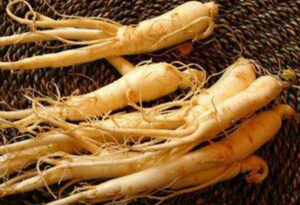 Ginseng
Ginseng
Ginseng refers to several species of perennial plants belonging to the Panax genus, particularly Panax ginseng (Asian or Korean ginseng) and Panax quinquefolius (American ginseng). The root of the ginseng plant has been used in traditional medicine for centuries due to its potential health benefits. It’s believed to have adaptogenic properties, meaning it may help the body cope with stress and promote overall well-being. Ginseng is often consumed in supplement form, teas, or as an ingredient in various health products. It’s purported to enhance cognitive function, boost energy levels, improve immune function, and even aid in managing symptoms of certain conditions like diabetes and erectile dysfunction, although scientific evidence supporting some of these claims is mixed and further research is ongoing.
Green Tea
Tea produced from the leaves of the Camellia sinensis plant is known as green tea. Green tea is lightly treated to preserve its natural components and green color, unlike black tea, which is subjected to oxidation. It has antioxidants known as catechins, especially epigallocatechin gallate (EGCG), which has been linked to several health advantages. Thanks to its antioxidant content, green tea is believed to have several health benefits, including boosting weight loss, enhancing brain function, and lowering the risk of numerous diseases. It is also highly regarded for its refreshing taste.
Herbs and Spices start with H
Herbs and Spices start with I
Herbs and Spices start with J
Herbs and Spices start with K
Herbs and Spices start with L
Herbs and Spices start with M
Herbs and Spices start with N
Herbs and Spices start with O
Herbs and Spices start with P
Herbs and Spices start with Q
Herbs and Spices start with R
Herbs and Spices start with S
Herbs and Spices start with T
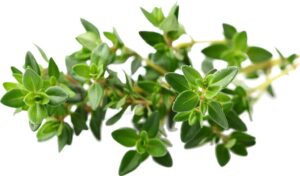 Thyme
Thyme
Thyme is a commonly used aromatic herb in cooking, known for its small green leaves and strong, earthy flavor. It belongs to the mint family (Lamiaceae) and is native to the Mediterranean region. Thyme is a versatile herb and is used in a variety of culinary dishes, including soups, stews, roasted meats, poultry, and vegetables. It is often used either fresh or dried, with the dried form being more readily available in most grocery stores.
Thyme has a pleasant, slightly savory and slightly floral flavor that pairs well with a wide range of ingredients and cuisines. It’s a key ingredient in many classic herb blends, such as herbes de Provence and bouquet garni. Thyme is also known for its medicinal properties and has been used traditionally for its potential health benefits, including its antimicrobial and antioxidant properties.
In addition to its culinary and medicinal uses, thyme is also cultivated as an ornamental plant and is appreciated for its low-growing, spreading habit and attractive foliage. There are several varieties of thyme, including common thyme (Thymus vulgaris), lemon thyme (Thymus citriodorus), and creeping thyme (Thymus serpyllum), each with its own unique flavor and uses.

